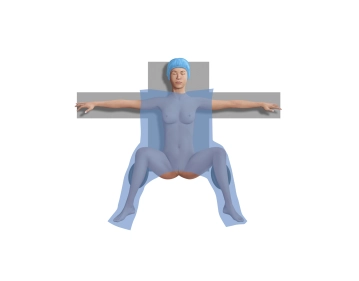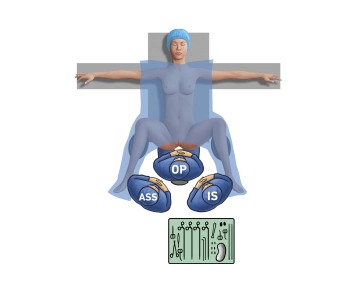- External full-wall rectal prolapse (grade III) in patients in whom abdominal surgery should be avoided (high-risk patients).
- Internal rectal prolapse (intussusception) as seen in obstructive defecation syndrome (ODS) with rather careful indication by an experienced coloproctologist.
-
Indications
-
Contraindications
- Relative contraindication in large prolapse
- General inoperability
- No burden of suffering
-
Preoperative diagnostic work-up
Medical history
Is the prolapse present only during defecation and physical exertion or is it permanent?
Often, peranal passage of blood is reported, e.g., from a solitary rectal ulcer (benign, common in rectal prolapse, always anterior).
Is there constipation or diarrhea, possibly alternating?
Other complaints are a feeling of incomplete bowel evacuation (= repetitive trips to the toilet with intense, futile straining attempts), tenesmus and mucus discharge.
There is almost always fecal incontinence with adverse social implications. For example, proximity to a toilet must always be assured, and a period of fasting observed before leaving home.
In women, urinary incontinence in pelvic floor prolapse is often a concomitant manifestation.Basic proctologic examination with inspection, palpation and proctorectoscopy
- Inspection/straining attempt: Regardless of how impressive advanced rectal prolapse may present: it may be easily overlooked if it only presents during defecation and if the patient avoids intense straining during the examination out of a sense of shame or - which is common - confuses straining with pinching. Often, the prolapse manifests only after several attempts at straining. If necessary, examine the patient in a squatting position or on the commode chair. Concentric mucosal folds are characteristic of complete rectal prolapse.
- Digital rectal examination: Active contraction and relaxation allow a rough assessment of the sphincter apparatus. With the patient straining, it may be possible to palpate an intussusception or rectocele. Mucosal induration may point to a solitary rectal ulcer.
- Proctoscopy: Intussusception is often (not always) recognizable as bulging of the anterior rectal wall through the anal canal when the proctoscope is withdrawn to the distal end of the anal canal and the patient is asked to strain.
- Rectoscopy: May be able to visualize a solitary rectal ulcer (always localized anteriorly).
Distal proctitis beginning at the anorectal junction and abruptly ending 10-12 cm from the anal verge is often accompanied by rectal prolapse.
Functional diagnostic work-up
Defecography can confirm a prolapse; it can be dispensed with if there is a clear diagnosis
- Standard defecography
In addition to rectal prolapse. standard defecography can also assess changes such as rectocele, intussusception and sigmoidocele. Since differential diagnosis defecography can detect both functional and morphological changes in the pelvic floor and rectosigmoid - as well as enteroceles in contrast enhanced studies - it is a powerful imaging modality, in particular, for pelvic floor dysfunction with the leading symptom of impaired bowel evacuation.
Due to the multifactorial etiology of pelvic floor dysfunction, mainly involving several compartments and often combined disorders, dynamic visualization of all pelvic organs is paramount.
Changes in the middle “gynecological” compartment and in the anterior, “urological” compartment of the pelvic floor cannot be visualized. In the past, this was only possible indirectly through additional contrast enhancement of the accessible organs by colpocystorectography. However, radiation exposure and the psychological stress should not be overlooked. - Dynamic pelvic floor MRI
Compared with standard defecography, dynamic pelvic floor MRI can provide a complete picture of the pelvic floor and its organs, since the anterior, middle and posterior compartments and any concomitant enteroceles can be visualized in one study and without radiation exposure. At the same time, dynamic pelvic floor MRI can depict the anatomical position of all pelvic organs during breathing, straining and pinching phases, both as single images and video sequences of great informational value.
In general, dynamic pelvic MRI (as MR defecography) offers the, mainly female, patients the benefit over standard defecography of being able to visualize all compartments and organ systems with enhanced patient comfort.
The main benefit is the lack of radiation exposure. Having the patient seated or recumbent does not change the study outcome. However, the morphological significance of dynamic MRI studies has not yet been fully clarified since normal and pathological findings overlap. - Endosonography (endoscopic ultrasound) is helpful if a sphincter defect is suspected.
- Additional function testing, such as electromyography and measurement of the nerve conduction velocity, is reserved for exceptional cases.
Colonoscopy
Preoperative standard modality to study colorectal topography and rule out other pathologies. -
Special preparation
- A simple enema on the evening before surgery and on the morning of the day of the operation is adequate for bowel preparation.
- Optional orthograde colonic lavage
In the operating room (OR):
- Perioperative antibiotic prophylaxis as single shot 1.5-3.0 g iv. ampicillin/sulbactam
- Foley catheter
-
Informed consent
General risks
- Bleeding
- Secondary bleeding
- Necessity of blood transfusions with corresponding transfusion risks
- Thromboembolism
- Wound infection
- Abscess
- Injury to adjacent organs/structures (internal female genitalia, urinary bladder)
Special risks
- Abscess formation
- Changes in stool habits
- Recurrent prolapse
- Persistent fecal or residual incontinence
- Supraanal rectal stenosis
-
Anästhesie
Depending on the patient‘s general condition:
- General anesthesia (general anesthesia)
- Regional anesthesia (spinal anesthesia, caudal anesthesia, Caudal anesthesia)
-
Positioning
![Positioning]()
- Lithotomy position
-
Operating room setup
![Operating room setup]()
- The seated surgeon faces the patient who is in the lithotomy position.
- The first assistant sits to the surgeon’s left.
- The scrub nurse stands or sits to the right of the surgeon.
-
Special instruments and fixation systems
- Lone Star Retractor™
- Toluidine blue
- Bipolar forceps
-
Postoperative management
Postoperative analgesia
- Continue epidural anesthesia until postoperative day 2 to 5
Follow these links to PROSPECT (Procedures Specific Postoperative Pain Management) or the current German guideline Leitlinien der Behandlung akuter perioperativer und posttraumatischer Schmerzen [Guidelines on treatment of acute perioperative and posttraumatic pain].
Postoperative management:
- Remove indwelling catheter as soon as possible
Deep venous thrombosis prophylaxis:
Unless contraindicated, the moderate risk of thromboembolism (surgical operating time > 30 minutes) calls for prophylactic physical measures and low-molecular-weight heparin, possibly adapted to weight or dispositional risk, until full ambulation is reached. Note: Renal function, HIT II (history, platelet check).
This link will provide you with the current German guidelines on prophylaxis in venous thromboembolism
Ambulation
- Immediate ambulation
- Phased return to full physical activity
Physical therapy
- Possibly prophylactic respiratory therapy for pneumonia
Diet
- The patient can drink freely on the day of surgery (yogurt + broth).
- From postoperative day 1, the patient can eat and drink normally.
Bowel movement:
- It is urgently recommended that management of bowel movement be consistently implemented during the postoperative period. The stools should be properly formed and of soft consistency to make the, often concomitant, incontinence tolerable (which is not automatically improved by the prolapse operation). We recommend psyllium husks or macrogol for management of bowel movement.
Discharge
- This is possible from postoperative day 2 to 4.
Work disability
- This is not relevant in most cases since the patients are elderly. In younger patients, depending on the individual case and occupation, between 2 and 4 weeks.


